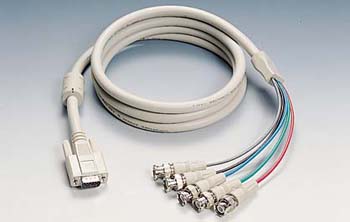|
While
many high-end monitors come equipped with BNC outputs, very
few consumers ever take advantage of them. Often targeted for
imaging professionals, due to expensive costs for a simple monitor
cable. With the further advancement of HDTV's, it's not uncommon
to find home entertainment equipment equipped with component
video. The BNC outputs on a monitor use a similar method of
image transfer as component video. Component video is often
regarded as the highest quality of image transferring available,
even better than the popular S-Video method.

How
does it work?
BNC is short for British Naval Connector or Bayonet Nut Connector
or Bayonet Neill Concelman. With a BNC monitor cable, instead
of the normal HD15, it sends each color to the video card separately
in order to avoid any signal digression. This allows the cable
to maintain the strongest video signal from the source. With
the higher quality signal in each color, the image overall becomes
much sharper and more vivid. In order to further maintain color
integrity, higher quality BNC cables are equipped with a ferrite
core in order to eliminate outside interference between the
colors.
Is
BNC for me?
BNC
cables have always been expensive, and not all monitors have
the option of BNC cables. More often you will find the option
on more expensive monitors, and the same monitor might cost
more just for the BNC outputs. The cables themselves have been
known to be up to $100 for one. Fortunately, there are suppliers
that have a much more reasonable solution. Symmic
offers them for a reasonable $11.95 plus shipping and handling.
Many
people claim that in order to see the true benefits of BNC,
you need to be running in high resolutions, preferably 1024x960
or higher. Because of this, these cables are unnecessary for
monitors that are 17" or smaller in most situations.
Next
>>
|